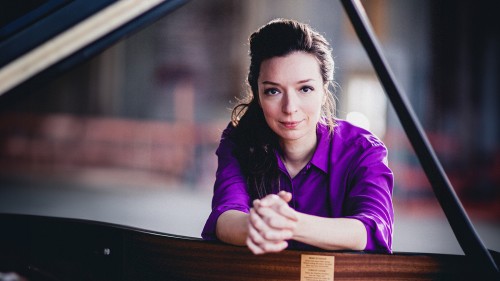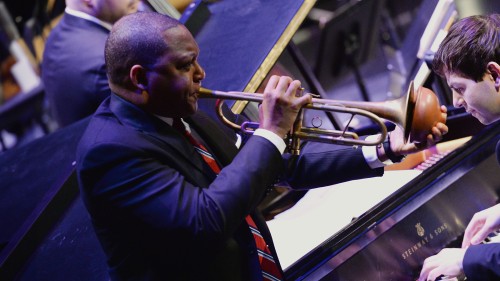
Yulianna Avdeeva, piano
in Cambridge, MA
This site uses cookies to measure our traffic and improve your experience. By clicking "OK" you consent to our use of cookies.
The Jerusalem Quartet
Alexander Pavlovsky, violin
Sergei Breisler, violin
Ori Kam, viola
Kyril Zlotnikov, cello
Since coming together as a quartet in 1993 and making their debut in 1996, the Jerusalem Quartet has impressed critics and moved audiences with striking interpretations of time-tested quartet repertoire and beyond. The members of this foursome have grown together as artists, becoming “a virtuosic ensemble with a glorious, meaty sound and irresistible panache” (The Guardian).
Highlighting their range, the Quartet’s program reflects three centuries of quartet repertoire, spanning the early Classical through twelve-tone modern styles. The program also encompasses countless moods: the clarity of Haydn’s monothematic movements, the teeming darkness and vigor of Shostakovich, and one of Dvořák’s loveliest slow movements.
Haydn’s Viennese publisher Artaria, capitalizing on the success of the composer’s Op. 33 quartets of 1782, wrote to the composer in 1784, offering him 300 florins for a new set of quartets. Haydn accepted, but then did not immediately start working on them because he was distracted by other in-process projects, in particular the Paris symphonies and The Seven Last Words. He did, however, finish the new quartets in July 1787.
Haydn chose to dedicate the Opus 50 quartets, which he called the “Prussian” quartets to honor his patron, Friedrich Wilhelm II, from whom he had received a gold ring with a letter thanking him for the Paris symphonies he had written. Haydn was proud of the ring and took the letter with him when he journeyed to England. He thought that he could express his gratitude in a fitting way with a printed dedication of a new quartet. On May 19, Haydn wrote to Artaria that he “felt ‘deeply in His Majesty’s debt because of this present,’ adding, “I can think of no better and more fitting way to show my thankfulness to His Majesty (and also in the eyes of the whole world) than by dedicating these six Quartets to him.” Artaria published them in late 1787 with a dedication to “Sa Majesté Frederic Guillaume II Roi de Prusse” (1744-1797), the nephew of Frederick the Great and one of the most notable patrons of music in 18th-century Germany. The works were eagerly sought by musicians all over Europe and quickly republished by Seiber in Paris, Hummel in Berlin, and Forster in London.
Friedrich Wilhelm II was a cellist, and Mozart composed a special part for him to play in his own “Prussian” quartets, K. 575, 589 and 590, a few years after Haydn completed his “Prussian” quartets. Subsequently, it became popular to refer to the “royal” cello part even though Haydn did not give the cello solo lines in quite the same overt way that Mozart later did. (Incidentally, Beethoven also wrote cello sonatas for Friedrich Wilhelm.)
Haydn’s letters from that year also give a detailed account of his compositional process and his musical goals, and how slowly and carefully he was working on what he knew would be an important series of quartets. They are more serious and experimental overall: In Op. 50, his stylistic approach is one step further along the path of his development than the Op. 33 quartets had been. He wrote longer movements, created bigger musical surprises, more intense humor, and frequently, he included more contrapuntal elaboration. Historically, Haydn’s Op. 50 quartets have been regarded as his response to the quartet set Mozart had dedicated to Haydn two years before. Although Haydn’s music ventures into unexpected chromatic territory on occasion, he never tries to emulate Mozart’s lyrical flexibility.
Haydn’s Op. 50 quartets, surprisingly, have always been relatively unknown, although they are among his finest musical creations. Only the two that were later given the nicknames, No. 5, “The Dream” and No. 6, “The Frog,” ever achieved success in the concert world. Overall, the six quartets have been judged less immediately appealing than the preceding set, Op.33. They display Haydn in a more intense and, perhaps, more intellectual mood.
Frederick William II was an avid amateur cellist and was a collector of chamber music that had prominent cello parts. In Op. 50, Haydn sought to free the cello from its traditional role until that time as the chief provider of simple, supporting bass lines. Haydn did not go so far as to compose concerto-like passages for his dedicatee because they would not have meshed with his more concentrated spare structures. Haydn was inclined to compose terse and basically monothematic movements rather than ones as lyrical and elegant as those Mozart had created in his earlier music. With Friedrich Wilhelm II in mind, Haydn composed the opening of the first movement to highlight the cello, beginning with two measures for cello alone, a solo for the king, on one note, repeated softly.
© Susan Halpern, 2024
Shostakovich’s family, which was originally Polish, settled in Russia two generations before the composer's birth, when his grandfather was released from exile in Siberia. His mother gave him his first piano lessons; at age 13, he entered the Petrograd Conservatory. When he completed his studies there, six years later, his graduation piece was his Symphony No. 1 (1924-25), a brilliant work that was soon performed internationally. Shostakovich had a long, fruitful career during which he proved to be music’s last great classicist, the composer of fifteen symphonies and fifteen string quartets and many other works.
Shostakovich came to maturity in an era when the government of the Soviet Union felt that their new society should support new kinds of art, and Russian composers, poets, novelists, and painters formed a true avant‑garde. Before long, their ideas changed, and Shostakovich’s symphonies and his two operas of the late 1920s and early 1930s were attacked by aesthetic theoreticians for such faults as “bourgeois decadence” and ideological “formalism,” and were even withdrawn from circulation. With his Symphony No. 5 (1937), which Shostakovich humbly described as “a composer's reply to just criticism,” he re‑entered the mainstream of Russian musical life, but continued to experience difficulties with the authorities until the time of Symphony No. 13 (1962), which he dedicated to the memory of the victims of the Nazi’s war‑time mass‑murders at Baba‑Yar. By then his eminent position as one of the world’s greatest living composers (which did not preserve him from public indignity in his homeland), prevented him from being silenced for long.
Shostakovich did not compose a string quartet until immediately after he composed his Fifth Symphony. By the time he wrote this quartet, his twelfth, in 1968, he was in what could be understood as the final stage of his career. He was suffering from a serious heart condition and also enduring considerable pain from arthritis. Perhaps the circumstances of his life had some carryover into the music, which has a dark and grief-stricken feel. While he was writing this quartet, Shostakovich confessed to a friend that every time he wrote a new work, he was haunted by fears that he would not live to complete it. This time, he was indeed very sick, and it was perfectly true that each new piece could have been his last.
Shostakovich completed Quartet No. 12 on March 11, 1968, at Repino (part of what is today called St. Petersburg), and the Beethoven Quartet, consisting of Dmitri Tsïganov, Nikolai Zabavnikov, Fyodor Druzhinin, and Sergei Shirinsky premiered it on June 14, 1968, at the USSR Composers’ Club in Moscow. It is the second in a set of four quartets. (After the Beethoven Quartet’s second violinist, Vasili Pyotrovich Shirinsky died, Shostakovich dedicated Quartet No. 11 to him; subsequently, he dedicated the next three quartets to the other members of the original quartet beginning with its first violinist Dmitri Mikhailovich Tsïganov. When Tsïganov asked Shostakovich to describe Quartet No. 12, the composer replied, “It’s a symphony, a symphony!”)
Musicologists considered Quartet No. 12 a problematic work with atonal elements. Over time, they decided that unquestionably the quartet is a bold work, but it should not be called a twelve-tone work because in some places, especially in the finale, the music returns to a clear-cut sense of diatonic tonality. Shostakovich’s sudden interest in atonal, twelve-tone techniques caused people to query how atonal music could be in the key of D-flat Major, even nominally? Although the quartet shows Shostakovich using twelve-tone techniques to generate motifs, he avoids immersing the work in serialism. Also, like many of Shostakovich’s late quartets, this work does not have a conventional four-movement structure but rather two movements only: a short first movement and a long second.
The work has two movements, the first short, and the second quite lengthy. The first movement, Moderato, begins with the much commented upon twelve-tone row that the cello states and with which it immediately sets a serious mood of quiet and sadness. Yet the theme maintains a feeling of nobility even though it expresses sorrow, and sometimes even seems calming although it is, nevertheless, without hope. The cello line immediately yields to a tonal theme. After the other instruments join in, there is a sudden change of time signature and tempo. The second theme is faster. The twelve tones return for the violin melody, marked Allegretto. The initial cello figure comes back in the viola with a change of tonality; it is followed by the Allegretto theme, now transferred to the cello. The rest of the movement develops this material before the piece closes quietly.
After all the restless harmonic and melodic exploration of the first movement, Shostakovich creates a gigantic, lengthy structure which has an almost orchestral effect. This movement, Allegretto - Adagio - Allegretto, reputedly fiendishly difficult to perform, is very wide-ranging, but nevertheless unified. It begins with the higher instruments trilling with savage, angry desperation. The trills yield to an emphatic response from the cello, an insistent melodic idea that begins with repeated notes and becomes shaped into a multitude of melodic ideas with unusual shapes and abruptly shifting textures. These two, the trills and the cello’s answer, account for the majority of the movement’s motivic material, but Shostakovich also expands the series of twelve tones that he introduced in the first movement so that this second and final movement of the work feels less like a single movement than an amalgamation of several contrasting ones.
Here, an almost symphonic working out of the initial twelve-tone sequence occurs in a frantic episode of many interacting twelve-tone sequences, some melodic, others not, interrupted by lyricism, haunting yet uncertain. Later, muted upper strings respond to an ardent cello line, which has been compared to a soliloquy. Shostakovich is able to sustain the tension through many fragmentary passages.
The first violin, pizzicato, repeats the twelve notes, in an ascending line, but the dark mood remains. As the development section unfolds, the material is woven densely, and again, motives which grew from the first movement material are developed further, in a more lyrical, faster section, Moderato. The rhythmic cello figure from the movement’s beginning takes on increasing weight toward the end of the movement. As the tempo increases, Shostakovich reprises material from the movement’s earlier parts as well as from the first movement. A long, steady crescendo follows; this has been interpreted as one of the most tranquilly exultant passages Shostakovich ever composed. By the quartet’s end, the chordal declaration of the major tonality, with its connotation of optimism, cannot be questioned.
It should be noted that when he had completed Quartet No. 12, Shostakovich continued to be interested in twelve-tone techniques and included them again in Quartet No. 13 and in his next two compositions, the Sonata for Violin and Piano, op. 134 and Symphony No. 14, op. 135.
© Susan Halpern, 2024
The father of Antonín Dvořák was a village innkeeper and butcher who hoped to pass his trade on to his son, but the young man turned instead towards music, took up the violin and organ, and at sixteen, left home to study in Prague. Five years later, he joined the orchestra of the National Theater, playing the viola. Soon he began to test his creative powers with extended compositions in the classical forms. Chamber music had an important place in Dvořák’s life. Many of his earliest works were quartets and quintets, modeled after those of Beethoven and Schubert, that he played with his colleagues and friends while developing his craft.
The Op. 106 string quartet, by contrast, is a late work, composed in 1895, when Dvořák had become one of the world’s most honored composers. In 1892, he was appointed the head of a new conservatory in New York, where he wrote some of the best music of his mature years: the “New World” symphony and the cello concerto, the “American” string quartet and a string quintet. Despite his enthusiasm for the young society on our continent, he knew that his art was rooted in his own homeland, Bohemia, and after spending a five-month leave in NY, in 1894 he decided that he could not remain in America much longer. In March 1895, he began a string quartet in New York, but he soon put it aside, and in April, he started on the journey back to Prague.
His first months in Prague were quiet, but when he began to teach at the Prague Conservatory again in the autumn, the creative urge returned. He completed the string quartet heard today in less than a month; he was so pleased with his work that he then took up the other that he had begun in New York and, in a few weeks, he had finished that one, too. Dvořák’s chamber music was in great demand, thus both works were quickly published, with the Op. 105 designation given to the one begun earlier in the United States, but finished after this one, Op. 106. In the manuscript of the G-major quartet Dvořák noted happily, “first composition after second return from America.”
The quartet is a work of warm and spontaneous invention, reflecting Dvořák‘s comfort and happiness at being home. The beginning of the optimistic first movement reflects this joy. Although some find the music of this work sounds very Czech, Dvořák rarely incorporated actual folk songs in his music, but rather composed new melodies that had the style or feeling of folk songs. The main theme of the first movement, Allegro moderato, does not have a conventional melody but instead a complex of carefree melodic motives that explore several keys and add up to something like a bird song; everywhere a rustling undercurrent of sound, like that heard in even the quietest places in nature, is evoked. The second theme is smooth, and a lilting third theme, characterized by flowing triplets, is also introduced. The development makes use of all three themes with rich harmony and modulation. In the recapitulation, a more delicate counter-melody is added to the first theme, while the second theme forms the basis of the coda.
The lyrical slow second movement, Adagio ma non troppo, is a freely formed meditation on a theme that Dvořák elevates to grand and passionate climaxes. It has been singled out as one of the most glorious creations the composer ever achieved. The next movement, Molto vivace, a scherzo, is developed and extended beyond the usual limits of the form. It has extraordinary vibrancy. A hopping Czech dance (skočná) provided the rhythmic inspiration for this movement.
The quartet ends with a Finale whose brief, slow introduction, Andante sostenuto, becomes transformed into the theme of a lively dance in the Czech furiant style, Allegro con fuoco, in the form of an ebullient rondo, during the course of which the first movement is recalled artfully.
© Susan Halpern, 2024
“...[the selections] all hit breathtaking levels of humanity, thanks to the singing interaction of the Jerusalems...”
The ArtsDesk
This performance is an Aaron Richmond Recital, endowed by Nancy Richmond Winsten and the late Dr. Joseph Winsten.

in Cambridge, MA

in Groton, MA




Stay in touch with Celebrity Series of Boston and get the latest.
Email Updates Sign up for Email Updates